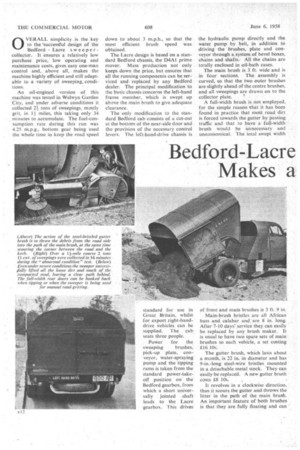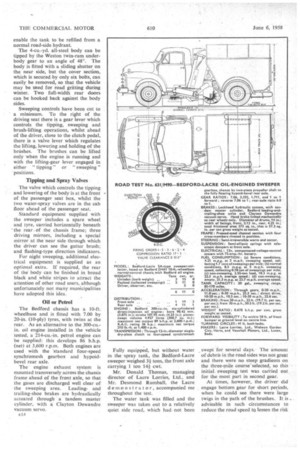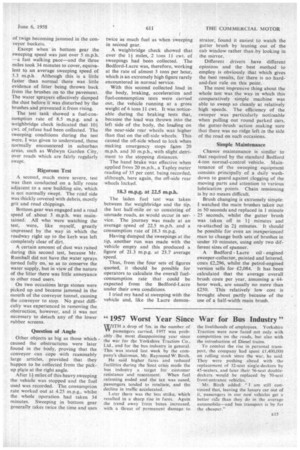Bedford-Lacre Makes a Clean Sweep
Page 56

Page 57

Page 58

Page 59

If you've noticed an error in this article please click here to report it so we can fix it.
By John F. Moon, A.M.I.R.T.E. OOVERALL simplicity is the key to the 'suceesSful design of the Bedford, Lacre w e e-p e r collector. It ensures a relatively low purchase price, low operating and maintenance costs, gives. easy one-man control and, above all, makes the machine highly efficient and still adaptable to a variety of sweeping, conditions.
An oil-engined version of this machine was tested in Welwyn Garden City, and under adverse conditions it collected 21, tons of sweepings, mostly grit, in 14miles, this taking only. 34 minutes to accumulate: The fuel-Consumption rate during this run was 4.25 tn.p.g,, bottom gear being used the whole time to keep the road speed down to about 3 m.p.h., so that the most efficient brush speed was obtained.
The Lacre design is based on a standard Bedford chassis, the D4A1 prime mover. Mass production not only keeps down the price, but ensures that all the running components can be serviced andreplaced by any Bedford dealer. The principal modification to the basic chassis concerns the left-hand frame member, which is swept up above the main brush to give adequate clearance.
The only modification to the standard Bedford cab consists of a cut-out at the bottom of the near-side door and the provision of the necessary control levers. The left-band-drive chassis is standard for use in Great Britain, whilst for export right-handdrive vehicles can be supplied. The cab seats three people.
Power for the
sweeping brushes, pick-up plate, conveyor, water-spraying pump and the tipping rams is taken from the standard power-takeoff position on the Bedford gearbox, from which a short universally jointed .shaft leads to the Lacre gearbox. This drives
the hydraulic pump directly and the water pump by belt, in addition to driving the brushes, plate and conveyor through-a system of bevel boxes, chains and shafts. All the chains are totally enclosed in oil-bath cases.
The main brush is 3 ft. wide and is in four sections. The assembly is curved, so that the two outer brushes are slightly ahead of the centre brushes, and allsweepings are drawn on to the collector plate.
A full-width brush is not-employed, for the simple reason that it has been found in practice that most road dirt is forced towards the gutter by passing traffic and that to have a full-width brush would be unnecessary and uneconomical. The total swept width of front and main brushes is 3 ft. 9 in.
Main-brush bristles are all African bass_ and calabar andare 8 in. long. After 7-10 days' service they can easily be replaced by any brush maker. It is usual to have two spare sets of main'. brushes to each vehicle, a set costing £16 10s.
The gutter brush, which lasts about a Month, is 22 in. in diameter and has 9-in-long steel-wire bristles. mounted in a detachable metal stock. They can easily-be replaced. A new gutter brush costs £8 10s.
It revolves in a clockwise direction. thus it scours the gutter and throws the litter in the path of the Main brush. An important feature of both brushes is that they are fully floating and can
therefore follow the road surface accurately. Sharp bumps or depressions are effectively cleaned and the main brush sections wear equally.
Rubber buckets, protected by steel brackets and mounted on two rubber belts, form the conveyor. This lifts the sweepings from the front of the revolving pick-up plate and ejects them into the body. The conveyor and its drive are arranged so that should any particularly large object be swept on to th.:.• pick-up plate and block the conveyor, the belt will slip on its pulleys without damaging the drive. A new conveyor-belt assembly costs £30 and lasts about a year.
The main brush can be locked in its raised position when travelling over long distances, which enables the sweeper to be used also for back-gritting. With the main brush raised but the front brush sweeping, and the front screen removed, grit is returned from the gutter to the centre _of the road.
A 180-gal. water tank behind the cab supplies the front and brush spray systems through the water pump. The front spray layout is 6 ft. wide and has three nozzles, with provision for a further two, whilst the brush spray is 3 ft. wide and has three nozzles.
Only the front spray is used except. under very dusty conditions, and the capacity of the water tank is such that it should hold sufficient water to enable the body to be filled with sweepings without stopping fOr water. Provision is made for carrying a stand pipe to
enable the tank to be refilled from a normal road-side hydrant.
The 4-cu.-yd. all-steel body can be tipped by the Weston twin-ram underbody gear to an angle of 48°. The body is fitted with a sliding shutter on the near side, but the cover section, which is secured by only six bolts, can easily be removed, so that the vehicle may be used for road gritting during winter. Two full-width rear doors can be hooked back against the body sides.
Sweeping controls have been cut to a minimum_ To the right of the driving seat there is a gear lever which controls the tipping, sweeping and brush-lifting operations, whilst ahead of the driver, close to the clutch pedal, there is a valve lever which regulates the lifting, lowering and holding of the brushes. The brushes can be lifted only when the engine is running and with the lifting-gear lever engaged in either " tipping" or " sweeping " positions.
Tipping and Spray Valves
The valve which controls the tipping and lowering of the body is at the front of the passenger seat box, whilst the two water-spray valves are in the cab floor ahead of the passenger seat.
Standard equipment supplied with the sweeper includes a spare wheel and tyre, carried horizontally beneath the rear of the chassis frame; three driving mirrors, including a special mirror at the near side through which the driver can see the gutter brush; and flashing-type direction indicators.
For night sweeping, additional electrical equipment is supplied as an optional extra. If required, the rear of the. body can be finished in broad black and white stripes to attract the attention of other road users, although unfortunately not many municipalities have adopted this idea.
Oil or Petrol
The Bedford chassis has a 10-ft. wheelbase and is fitted with 7.00 by 20-in. (10-ply) tyres, with twins at the rear. As an alternative to the 300-cuin. oil engine installed in the vehicle tested, a 214-cu.-in. petrol engine can be supplied: this develops 86 b.h.p. (net) at 3,600 r.p.m. Both engines are used with the standard four-speed synchromesh gearbox and hypoidbevel rear axle.
The engine exhaust system is mounted transversely across the chassis frame ahead of the front axle, so that the gases are discharged well clear of the sweeping area. Leadingand trailing-shoe brakes are hydraulically actuated through a tandem master cylinder, with a Clayton Dewandre vacuum Servo.
Fully equipped, but without water in the spray tank, the Bedford-Lacre sweeper weighed 3* tons, the front axle carrying 1 ton 141 cwt.
Mr. Donald Thomas, managing director of Lacre Lorries, Ltd., and Mr. Desmond Rumbail, the Lacre demonstrator, accompanied me throughout the test.
The water tank was filled and the sweeper was taken out to a relatively quiet side road, which had not been
_ swept for several days. The amount of debris in the road sides was not great and there were no steep gradients on the three-mile course selected, so this initial sweeping test was cafried out for the most part in second gear.
At times, however, the driver did engage bottom gear for short periods, when be could see there were -large twigs in the path of the brushes. It is advisable in such circumstances to reduce the road speed to lessen the risk
of twigs becoming jammed in the conveyor buckets.
Except when in bottom gear the sweeping speed was just over 5 m.p.h. —a fast walking pace—and the three miles took 34 minutes to cover, equivalent to an average sweeping speed of 5.3 m.p.h. Although this is a little faster than normal there was little evidence of litter being thrown back from the brushes on to the pavement. The water sprayers effectively damped the dust before it was disturbed by the brushes and prevented it from rising.
The test tank showed a fuel-consumption rate of 8.5 mpg. and a weighbridge check indicated that 10+ cwt. of refuse had been collected. The sweeping conditions during the test were, I was given to understand, those normally encountered in suburban areas, such as Welwyn Garden City, over roads which are fairly regularly swept.
Rigorous Test
A second, much more severe, test was then conducted on a hilly route adjacent to a new building site, which is not normally swept. The road side was thickly covered with debris, mostly grit and road chippings.
Bottom gear was engaged and a road speed of about 3 m.p.h. was maintained. All who were watching the test, were, like myself, greatly impressed by the way in which the roadway right up to the kerb was left completely clear of dirt.
A certain amount of dust was raised during this second test, because Mr. Rum ball did not have the water sprays turned fully on, so as to conserve the water supply, but in view of the nature of the litter there was little annoyance to other road users.
On two occasions large stones were picked up and became jammed in the mouth of the conveyor tunnel, causing the conveyor to stop. No great difficulty was experienced in removing the obstruction, however, and it was not necessary to detach any of the lower rubber screens.
Question of Angle
Other objects as big as those which caused the obstructions were later found in the body, proving that the conveyor can cope With reasonably large articles, provided that they happen to be collected from the pickup plate at the right angle.
After 1+ miles of this heavy sweeping the vehicle was stopped and the fuel used was recorded. The consumption rate worked out at 4.25 m.p.g., whilst the whole operation had taken 34 minutes. Sweeping in bottom gear generally takes twice the time and uses
twice as much fuel as when sweeping in second gear.
A weighbridge check showed that over the 1+ miles, 2 tons 11 cwt. of sweepings had been collected. The Bedford-Lacre was, therefore, working at the rate of almost 5 tons per hour, which is an extremely high figure rarely encountered in normal service.
With this second collected load in the body, braking, acceleration and fuel-consumption tests were carried out, the vehicle running at a gross weight of 6 tons 11 cwt. It was notice able during the braking tests that, because the load was thrown into the left side of the body, the loadding on the near-side rear wheels was higher than that on the off-side wheels. This
caused the off-side wheel to lock when making emergency stops aim 20 m.p.h. and 30 m.p.h., with slight detriment to the stopping distances.
The hand brake was effective when applied from 20 m.p.h., a Tapley meter reading of 35 per cent. being recorded, although, here again, the off-side rear wheels locked.
18.3 m.p.g. at 22.5 m.p.h.
The laden fuel test was taken between the weighbridge and the tip, the last hall-mile or so consisting of unmade roads, as would occur in service. The journey was made at an average speed of 22.5 m.p.h. and a consumption rate of 18.3 m.p.g.
Having dumped the sweepings at the tip, another run was made with the• vehicle empty and this produced a figure of 21.3 m.p.g. at 23.7 average speed.
Thus, from the four sets of figures quoted, it should be possible for operators to calculate the overall fuelconsumption rate that could be expected from the Bedford-Lacre under their own conditions.
I tried my hand at sweeping with the vehicle and, like the Lacre demon strator, found it easiest to watch the gutter brush by leaning out of the cab window rather than .by looking in the mirror.
Different drivers have different opinions and the best method to employ is obviously that which gives the best results, for there is no hardand-fast rule on this point.
The most impressive thing about the whole test was the wayin which this comparatively simple machine was able to sweep so cleanly at relatively high speeds. The efficiency of the sweeper was particularly noticeable when pulling out round parked cars, the gutter-brush action making sure that there was no ridge left in the side of the road on such occasions.
Simple Maintenance
Chassis maintenance is similar to that required by the standard Bedford 4-ton normal-control vehicle. Maintenance of the sweeping equipment consists principally of a daily washdown to guard against clogging of the moving parts and attention to various lubrication points. Chain tensioning is by no means difficult.
Brush changing is extremely simple: I watched the main brushes taken out in 50 seconds and replaced in 1 minute 25 seconds, whilst the gutter brush was taken off in 11 minutes and re-attached in 2minutes. • It should be possible for even an inexperienced man to change both sets of brushes in under 10 minutes, using only two different sizes of spanner.
A Bedford Lacre oil engined sweeper-collector, painted and lettered, costs £2,296, whilst the petrol-engined version sells for £2,084. It has been calculated that the average overall brush costs per year, assuming a 44hour week, are usually no more than £250. This relatively low cost is brought about partly because of the use of a half-width main brush.








































































































































